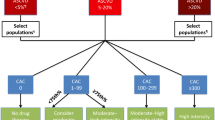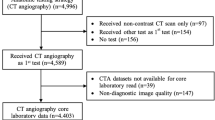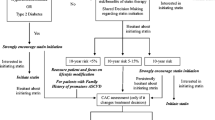Abstract
Risk stratification in patients with suspected coronary artery disease (CAD) is important. Recently, the minimal-risk-tool (MRT) was developed to identify individuals with low CAD risk despite symptoms in order to avoid unnecessary testing. We aimed to validate and update the MRT-model in a contemporary cohort. The Dan-NICAD trial cohort, consisting of 1675 consecutive patients referred for coronary computed tomography angiography (CTA), was used to calculate the MRT-score based on the published fitted variable coefficients from the PROMISE and SCOT-HEART trials. Minimal risk was defined as zero calcium score, no coronary atherosclerosis at coronary CTA, and no cardiovascular events in the follow-up period. We tested an updated MRT-model by pooling the fitted variable coefficients from all three trials. A total of 1544 patients fulfilling the inclusion criteria were followed for 3.1 [2.7–3.4] years. In 710 (46%) patients, the criteria for minimal risk were fulfilled. Despite substantial coefficient variation, the MRTs based on the PROMISE, the SCOT-HEART and the updated MRT variables showed similar moderate to high discriminative performance for minimal risk estimation. Although all three models tended to underestimate minimal risk, the updated MRT had the best performance. Using a 75% minimal risk cut-off, the updated MRT showed a sensitivity of 11.6% (95% CI 9.3–14.2%) and specificity of 99.3% (95% CI 98.6–99.8%). An updated MRT model based on three large studies increased calibration compared to the existing MRT models, whereas discrimination was similar despite substantial coefficient variation. The updated MRT might supplement currently recommended pre-test probability models.


Similar content being viewed by others

Abbreviations
- PTP:
-
Pre-test probability
- CAD:
-
Coronary artery disease
- ESC:
-
European Society of Cardiology
- PROMISE:
-
Prospective Multicenter Imaging Study for Evaluation of Chest Pain
- SCOT-HEART:
-
Scottish COmputed Tomography of the HEART trial
- MRT:
-
Minimal risk tool
- Dan-NICAD:
-
Danish study of Non-Invasive testing in Coronary Artery Disease
- CTA:
-
Computed tomography angiography
- HDL:
-
High-density lipoprotein
- AUC:
-
Area under the receiver-operator curve
- PPV:
-
Positive predictive values
- NPV:
-
Negative predictive values
References
Knuuti J, Wijns W, Saraste A et al (2020) 2019 ESC guidelines for the diagnosis and management of chronic coronary syndromes. Eur Heart J. 41(3):407–477
Juarez-Orozco LE, Saraste A, Capodanno D et al (2019) Impact of a decreasing pre-test probability on the performance of diagnostic tests for coronary artery disease. Eur Heart J Cardiovasc Imaging 20(11):1198–1207
Winther S, Nissen L, Westra J et al (2019) Pre-test probability prediction in patients with a low to intermediate probability of coronary artery disease: a prospective study with a fractional flow reserve endpoint. Eur Heart J Cardiovasc Imaging 20(11):1208–1218
Bing R, Singh T, Dweck MR, et al (2020) Validation of European Society of Cardiology pre-test probabilities for obstructive coronary artery disease in suspected stable angina. Eur Heart J Qual Care Clin Outcomes
Maron DJ, Hochman JS, Reynolds HR et al (2020) Initial invasive or conservative strategy for stable coronary disease. N Engl J Med. 382(15):1395–1407
Boden WE, O'Rourke RA, Teo KK et al (2007) Optimal medical therapy with or without PCI for stable coronary disease. N Engl J Med 356(15):1503–1516
De Bruyne B, Pijls NH, Kalesan B et al (2012) Fractional flow reserve-guided PCI versus medical therapy in stable coronary disease. N Engl J Med 367(11):991–1001
Investigators S-H, Newby DE, Adamson PD et al (2018) Coronary CT angiography and 5-year risk of myocardial infarction. N Engl J Med 379(10):924–933
Adamson PD, Williams MC, Dweck MR et al (2019) Guiding therapy by coronary CT angiography improves outcomes in patients with stable chest pain. J Am Coll Cardiol 74(16):2058–2070
Fordyce CB, Douglas PS, Roberts RS et al (2017) Identification of patients with stable chest pain deriving minimal value from noninvasive testing: the PROMISE minimal-risk tool, a secondary analysis of a randomized clinical trial. JAMA Cardiol 2(4):400–408
Adamson PD, Fordyce CB, McAllister DA, Udelson JE, Douglas PS, Newby DE (2018) Identification of patients with stable chest pain deriving minimal value from coronary computed tomography angiography: an external validation of the PROMISE minimal-risk tool. Int J Cardiol 252:31–34
Nissen L, Winther S, Isaksen C et al (2016) Danish study of Non-Invasive testing in Coronary Artery Disease (Dan-NICAD): study protocol for a randomised controlled trial. Trials 17(1):262
Nissen L, Winther S, Westra J et al (2018) Diagnosing coronary artery disease after a positive coronary computed tomography angiography: the Dan-NICAD open label, parallel, head to head, randomized controlled diagnostic accuracy trial of cardiovascular magnetic resonance and myocardial perfusion scintigraphy. Eur Heart J Cardiovasc Imaging 19(4):369–377
Steyerberg EW, Vergouwe Y (2014) Towards better clinical prediction models: seven steps for development and an ABCD for validation. Eur Heart J 35(29):1925–1931
Debray TP, Vergouwe Y, Koffijberg H, Nieboer D, Steyerberg EW, Moons KG (2015) A new framework to enhance the interpretation of external validation studies of clinical prediction models. J Clin Epidemiol 68(3):279–289
Moons KG, Kengne AP, Grobbee DE et al (2012) Risk prediction models: II. External validation, model updating, and impact assessment. Heart 98(9):691–698
Rana JS, Tabada GH, Solomon MD et al (2016) Accuracy of the atherosclerotic cardiovascular risk equation in a large contemporary multiethnic population. J Am Coll Cardiol 67(18):2118–2130
Douglas PS, Hoffmann U, Patel MR et al (2015) Outcomes of anatomical versus functional testing for coronary artery disease. N Engl J Med 372(14):1291–1300
Fordyce CB, Newby DE, Douglas PS (2016) Diagnostic strategies for the evaluation of chest pain: clinical implications from SCOT-HEART and PROMISE. J Am Coll Cardiol 67(7):843–852
The SCOT (2015) CT coronary angiography in patients with suspected angina due to coronary heart disease (SCOT-HEART): an open-label, parallel-group, multicentre trial. The Lancet. 385(9985):2383–2391
Genders TS, Steyerberg EW, Hunink MG et al (2012) Prediction model to estimate presence of coronary artery disease: retrospective pooled analysis of existing cohorts. BMJ 344:e3485
Wasfy MM, Brady TJ, Abbara S et al (2012) Comparison of the Diamond-Forrester method and Duke Clinical Score to predict obstructive coronary artery disease by computed tomographic angiography. Am J Cardiol 109(7):998–1004
Spertus JA, Maron DJ, Cohen DJ et al (2013) Frequency, predictors, and consequences of crossing over to revascularization within 12 months of randomization to optimal medical therapy in the Clinical Outcomes Utilizing Revascularization and Aggressive Drug Evaluation (COURAGE) trial. Circ Cardiovasc Qual Outcomes 6(4):409–418
Acknowledgements
The study was supported by The Danish Heart Foundation (Grant No. 15-R99-A5837-22920) and the Health Research Fund of Central Denmark Region.
Author information
Authors and Affiliations
Corresponding author
Ethics declarations
Conflict of interest
MOB is an advisory board member of Novo Nordisk, Bayer, ACARIX, SANOFI and Astra Zeneca. SW received support from Acarix in the form of an institutional research Grant. All other authors have nothing to declare.
Additional information
Publisher's Note
Springer Nature remains neutral with regard to jurisdictional claims in published maps and institutional affiliations.
Laust Dupont Rasmussen, Louise Nissen, Jelmer Westra, Lars Lyhne Knudsen, Lene Helleskov Madsen, Niels Ramsing Holm, Evald Høj Christiansen, Hans Erik Bøtker, Morten Bøttcher, and Simon Winther authors takes responsibility for all aspects of the reliability and freedom from bias of the data presented and their discussed interpretation.
Electronic supplementary material
Below is the link to the electronic supplementary material.
Rights and permissions
About this article
Cite this article
Rasmussen, L.D., Nissen, L., Westra, J. et al. Validation and update of the minimal risk tool in patients suspected of chronic coronary syndrome. Int J Cardiovasc Imaging 37, 699–706 (2021). https://doi.org/10.1007/s10554-020-01982-7
Received:
Accepted:
Published:
Issue Date:
DOI: https://doi.org/10.1007/s10554-020-01982-7



